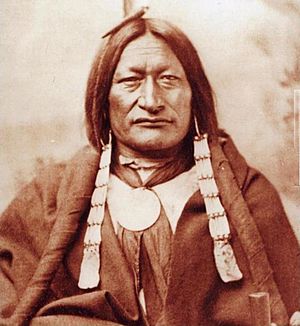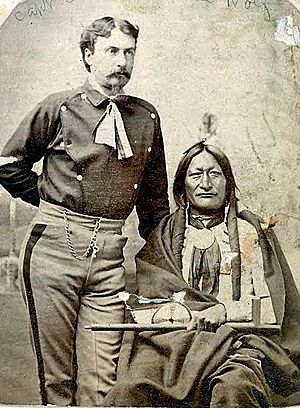Little Hawk facts for kids
Quick facts for kids
Little Hawk
|
|
|---|---|
| Čhetáŋ Čík’ala | |
| Oglala Lakota leader | |
| Personal details | |
| Born | 1836 Dakota |
| Died | 1900 Pine Ridge |
| Spouses | Sunk ska win, White Horse Woman (possibly his second wife) |
| Relations | Half-brother of Worm |
| Children | Luke Little hawk |
| Known for | Chief |
Little Hawk (in Lakota: Čhetáŋ Čík’ala) was an Oglala Lakota war chief. He was born around 1836 and passed away in 1900. Little Hawk was the half-brother of Worm, who was the father of the famous chief Crazy Horse. This made Little Hawk the uncle of Crazy Horse, though in Lakota tradition, they were considered like brothers.
Contents
Little Hawk's Family and Relatives
Little Hawk was born in 1836. His father was a holy man named Makes the Song. Makes the Song was also the father of Worm. Worm later became the father of the well-known chief Crazy Horse.
Little Hawk's mother was named Good Haired Otter. She was a different mother from Worm's mother. In the Lakota way of looking at family, Crazy Horse was seen as a brother to Little Hawk.
Little Hawk's wife was named Sunk-ska-win, also known as White Horse Woman. She was the sister of Iron Hawk. White Horse Woman said she was married to Little Hawk for thirty years. They had several children together, including Chase in Morning, Many Cartridges, and Luke Little Hawk.
Understanding Lakota Names
Sometimes, people in the Lakota culture would give their name to a younger family member. One of Little Hawk's nephews, who was Crazy Horse's younger brother, was given the name Little Hawk. This nephew was later called 'Long Face'.
This nephew Little Hawk was killed in 1871. After his death, 'Long Face' took back his original name, Little Hawk. This custom of sharing names can sometimes make it tricky to know which person did what.
Life as a Lakota Leader
During the 1860s and 1870s, Little Hawk fought alongside his famous nephew, Crazy Horse. Crazy Horse was only four years younger than Little Hawk. Little Hawk was known for being part of important battles.
He was one of the warriors who fought in The Battle of the Little Bighorn. Little Hawk wanted to protect his people's hunting lands. He chose to fight with Crazy Horse against the U.S. troops. He did not want to go into Canada with Sitting Bull.
General George Crook wrote about Little Hawk. He said Little Hawk seemed to be the next most important leader after Crazy Horse. He noted that Little Hawk looked a lot like Crazy Horse. However, Little Hawk's face was kinder, and he spoke more easily. He often did most of the talking for the group.
Surrender and Peace Medal
Crazy Horse and Little Hawk arrived at Fort Robinson on May 6, 1877. They met with First Lieutenant William P. Clark. This meeting was the first step in their formal surrender.
Some people who saw the surrender noticed something shiny on Little Hawk's neck. It was a peace medal with the image of President James Monroe. John G. Bourke wrote that the medal was given to Little Hawk's father in 1817. Other stories say Little Hawk mentioned the medal was given to his grandfather. After many years, this symbol of friendship had become more of a decoration.
After Crazy Horse's death, Little Hawk became a leader of his nephew's band, the Hunkpatila. He tried to help his people adjust to life on the reservation.
Joining Sitting Bull in Canada
In early 1878, Little Hawk and He Dog led their Oglala people away from the agency. They wanted to join Sitting Bull's resistance. Other groups, like some Brulés and Miniconjous, also joined them. About eighty lodges, or families, left the agency.
They traveled northwest, avoiding army patrols. Little Hawk did a great job leading the journey. They crossed into Canada in March and met up with Sitting Bull's group. This added about 280 lodges to Sitting Bull's alliance. This almost doubled their numbers.
For the next three years, these Lakota people tried to live freely in Canada. But life became very hard. The buffalo herds, which they relied on for food, became very scarce. This was due to hunting by many groups.
Because of the difficult conditions and hunger, many Lakota bands began to surrender. Little Hawk surrendered at Fort Keogh in September 1880.
Return to Pine Ridge
In 1881, the Lakota people who had surrendered were moved. They were held at the Standing Rock Agency. A year later, 656 Northern Oglalas were released. Little Hawk, along with Big Road, He Dog, and Low Dog, led them back home to Pine Ridge.
In 1888, Little Hawk was part of a Lakota group that went to Washington. They were there for a delegation, likely to discuss their people's future.
After the Wounded Knee Massacre on January 6, 1891, Little Hawk helped negotiate the terms of surrender. On January 24, he led a group of about twenty Indians. They came to the Pine Ridge agency to surrender thirty-one guns. This was part of an order to disarm the Native Americans.
Little Hawk's Later Years
Little Hawk's name last appears in the Pine Ridge census in 1899. It is believed he passed away either late that year or in early 1900.



